Business Environment and Strategic Management
VerifiedAdded on 2020/10/05
|12
|3297
|496
AI Summary
The provided assignment is a collection of research papers and articles on the topic of business environment and strategic management. It covers various aspects such as organizational innovation, technological innovation capabilities, services industry evolution, business resilience, closed-loop supply chains, environmental strategies, and more. The document aims to provide insights and knowledge on how businesses can navigate and adapt to changing environments, making informed decisions to stay competitive.
Contribute Materials
Your contribution can guide someone’s learning journey. Share your
documents today.
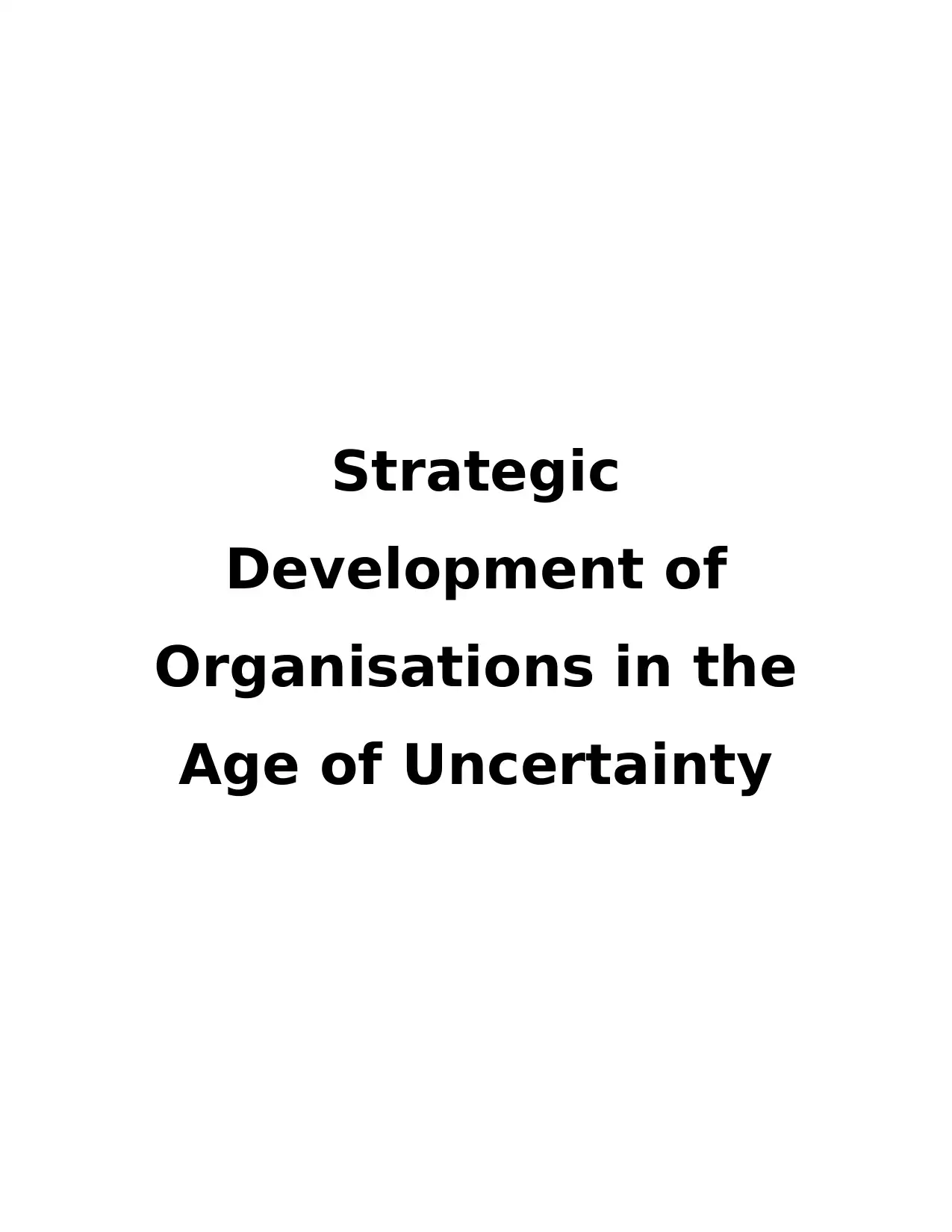
Strategic
Development of
Organisations in the
Age of Uncertainty
Development of
Organisations in the
Age of Uncertainty
Secure Best Marks with AI Grader
Need help grading? Try our AI Grader for instant feedback on your assignments.
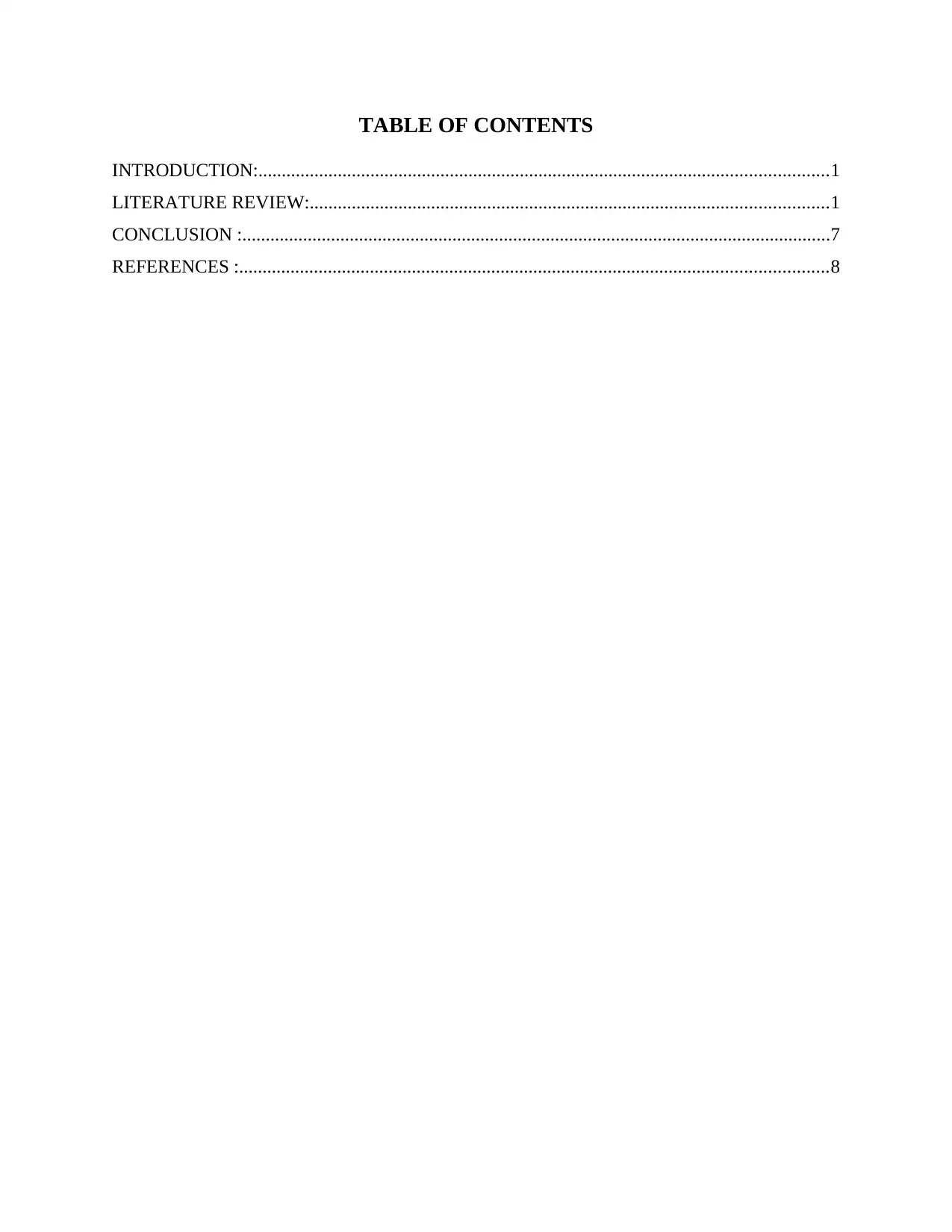
TABLE OF CONTENTS
INTRODUCTION:..........................................................................................................................1
LITERATURE REVIEW:...............................................................................................................1
CONCLUSION :..............................................................................................................................7
REFERENCES :..............................................................................................................................8
INTRODUCTION:..........................................................................................................................1
LITERATURE REVIEW:...............................................................................................................1
CONCLUSION :..............................................................................................................................7
REFERENCES :..............................................................................................................................8
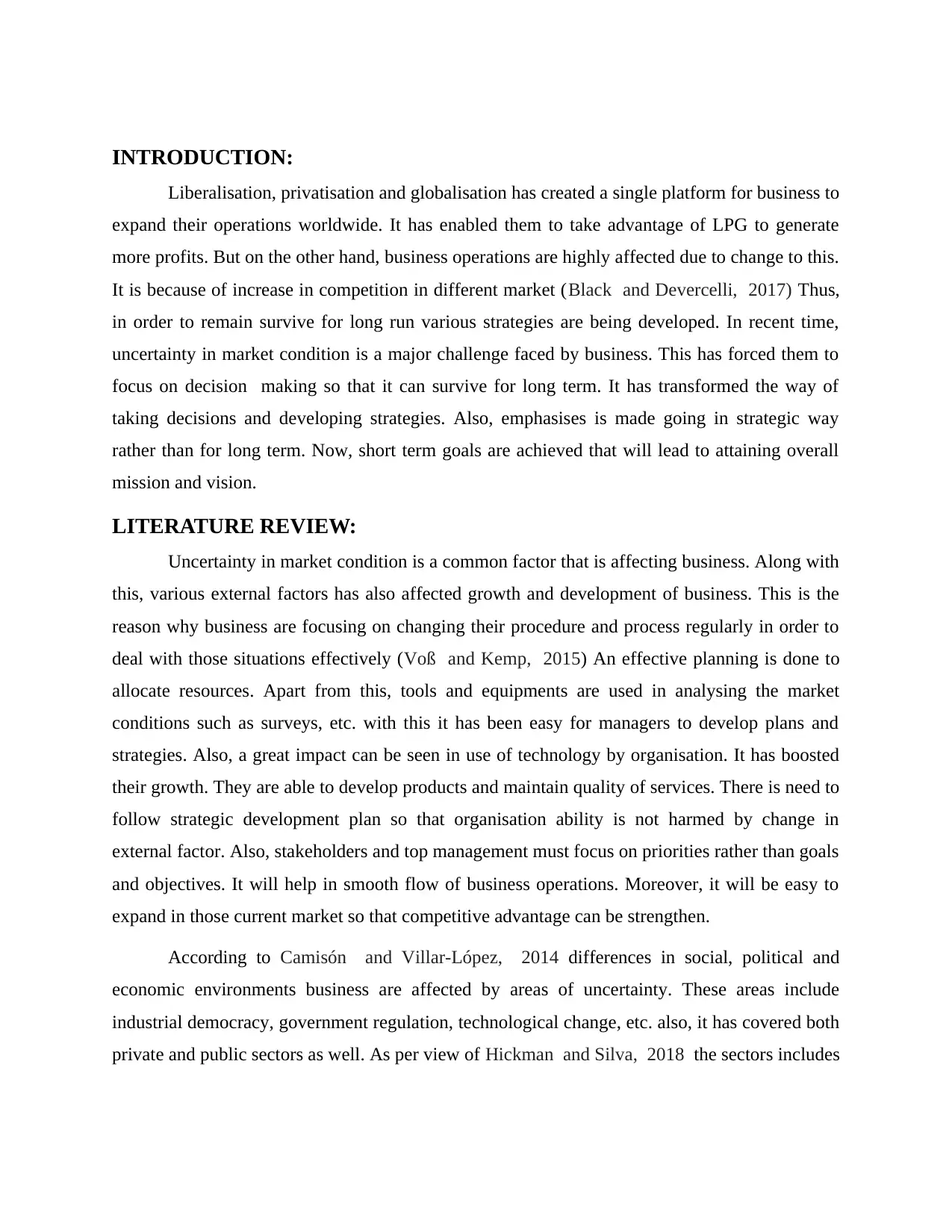
INTRODUCTION:
Liberalisation, privatisation and globalisation has created a single platform for business to
expand their operations worldwide. It has enabled them to take advantage of LPG to generate
more profits. But on the other hand, business operations are highly affected due to change to this.
It is because of increase in competition in different market (Black and Devercelli, 2017) Thus,
in order to remain survive for long run various strategies are being developed. In recent time,
uncertainty in market condition is a major challenge faced by business. This has forced them to
focus on decision making so that it can survive for long term. It has transformed the way of
taking decisions and developing strategies. Also, emphasises is made going in strategic way
rather than for long term. Now, short term goals are achieved that will lead to attaining overall
mission and vision.
LITERATURE REVIEW:
Uncertainty in market condition is a common factor that is affecting business. Along with
this, various external factors has also affected growth and development of business. This is the
reason why business are focusing on changing their procedure and process regularly in order to
deal with those situations effectively (Voß and Kemp, 2015) An effective planning is done to
allocate resources. Apart from this, tools and equipments are used in analysing the market
conditions such as surveys, etc. with this it has been easy for managers to develop plans and
strategies. Also, a great impact can be seen in use of technology by organisation. It has boosted
their growth. They are able to develop products and maintain quality of services. There is need to
follow strategic development plan so that organisation ability is not harmed by change in
external factor. Also, stakeholders and top management must focus on priorities rather than goals
and objectives. It will help in smooth flow of business operations. Moreover, it will be easy to
expand in those current market so that competitive advantage can be strengthen.
According to Camisón and Villar-López, 2014 differences in social, political and
economic environments business are affected by areas of uncertainty. These areas include
industrial democracy, government regulation, technological change, etc. also, it has covered both
private and public sectors as well. As per view of Hickman and Silva, 2018 the sectors includes
Liberalisation, privatisation and globalisation has created a single platform for business to
expand their operations worldwide. It has enabled them to take advantage of LPG to generate
more profits. But on the other hand, business operations are highly affected due to change to this.
It is because of increase in competition in different market (Black and Devercelli, 2017) Thus,
in order to remain survive for long run various strategies are being developed. In recent time,
uncertainty in market condition is a major challenge faced by business. This has forced them to
focus on decision making so that it can survive for long term. It has transformed the way of
taking decisions and developing strategies. Also, emphasises is made going in strategic way
rather than for long term. Now, short term goals are achieved that will lead to attaining overall
mission and vision.
LITERATURE REVIEW:
Uncertainty in market condition is a common factor that is affecting business. Along with
this, various external factors has also affected growth and development of business. This is the
reason why business are focusing on changing their procedure and process regularly in order to
deal with those situations effectively (Voß and Kemp, 2015) An effective planning is done to
allocate resources. Apart from this, tools and equipments are used in analysing the market
conditions such as surveys, etc. with this it has been easy for managers to develop plans and
strategies. Also, a great impact can be seen in use of technology by organisation. It has boosted
their growth. They are able to develop products and maintain quality of services. There is need to
follow strategic development plan so that organisation ability is not harmed by change in
external factor. Also, stakeholders and top management must focus on priorities rather than goals
and objectives. It will help in smooth flow of business operations. Moreover, it will be easy to
expand in those current market so that competitive advantage can be strengthen.
According to Camisón and Villar-López, 2014 differences in social, political and
economic environments business are affected by areas of uncertainty. These areas include
industrial democracy, government regulation, technological change, etc. also, it has covered both
private and public sectors as well. As per view of Hickman and Silva, 2018 the sectors includes
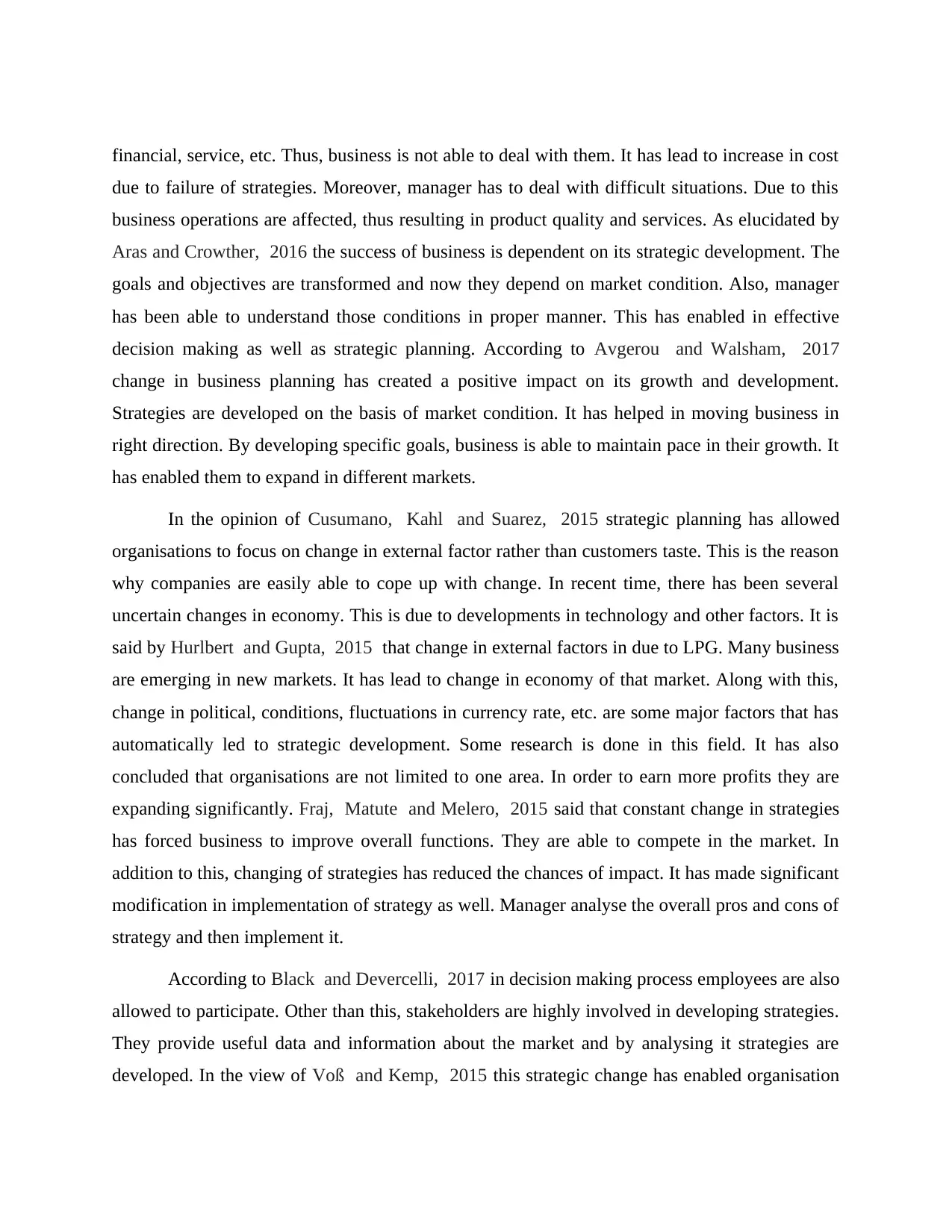
financial, service, etc. Thus, business is not able to deal with them. It has lead to increase in cost
due to failure of strategies. Moreover, manager has to deal with difficult situations. Due to this
business operations are affected, thus resulting in product quality and services. As elucidated by
Aras and Crowther, 2016 the success of business is dependent on its strategic development. The
goals and objectives are transformed and now they depend on market condition. Also, manager
has been able to understand those conditions in proper manner. This has enabled in effective
decision making as well as strategic planning. According to Avgerou and Walsham, 2017
change in business planning has created a positive impact on its growth and development.
Strategies are developed on the basis of market condition. It has helped in moving business in
right direction. By developing specific goals, business is able to maintain pace in their growth. It
has enabled them to expand in different markets.
In the opinion of Cusumano, Kahl and Suarez, 2015 strategic planning has allowed
organisations to focus on change in external factor rather than customers taste. This is the reason
why companies are easily able to cope up with change. In recent time, there has been several
uncertain changes in economy. This is due to developments in technology and other factors. It is
said by Hurlbert and Gupta, 2015 that change in external factors in due to LPG. Many business
are emerging in new markets. It has lead to change in economy of that market. Along with this,
change in political, conditions, fluctuations in currency rate, etc. are some major factors that has
automatically led to strategic development. Some research is done in this field. It has also
concluded that organisations are not limited to one area. In order to earn more profits they are
expanding significantly. Fraj, Matute and Melero, 2015 said that constant change in strategies
has forced business to improve overall functions. They are able to compete in the market. In
addition to this, changing of strategies has reduced the chances of impact. It has made significant
modification in implementation of strategy as well. Manager analyse the overall pros and cons of
strategy and then implement it.
According to Black and Devercelli, 2017 in decision making process employees are also
allowed to participate. Other than this, stakeholders are highly involved in developing strategies.
They provide useful data and information about the market and by analysing it strategies are
developed. In the view of Voß and Kemp, 2015 this strategic change has enabled organisation
due to failure of strategies. Moreover, manager has to deal with difficult situations. Due to this
business operations are affected, thus resulting in product quality and services. As elucidated by
Aras and Crowther, 2016 the success of business is dependent on its strategic development. The
goals and objectives are transformed and now they depend on market condition. Also, manager
has been able to understand those conditions in proper manner. This has enabled in effective
decision making as well as strategic planning. According to Avgerou and Walsham, 2017
change in business planning has created a positive impact on its growth and development.
Strategies are developed on the basis of market condition. It has helped in moving business in
right direction. By developing specific goals, business is able to maintain pace in their growth. It
has enabled them to expand in different markets.
In the opinion of Cusumano, Kahl and Suarez, 2015 strategic planning has allowed
organisations to focus on change in external factor rather than customers taste. This is the reason
why companies are easily able to cope up with change. In recent time, there has been several
uncertain changes in economy. This is due to developments in technology and other factors. It is
said by Hurlbert and Gupta, 2015 that change in external factors in due to LPG. Many business
are emerging in new markets. It has lead to change in economy of that market. Along with this,
change in political, conditions, fluctuations in currency rate, etc. are some major factors that has
automatically led to strategic development. Some research is done in this field. It has also
concluded that organisations are not limited to one area. In order to earn more profits they are
expanding significantly. Fraj, Matute and Melero, 2015 said that constant change in strategies
has forced business to improve overall functions. They are able to compete in the market. In
addition to this, changing of strategies has reduced the chances of impact. It has made significant
modification in implementation of strategy as well. Manager analyse the overall pros and cons of
strategy and then implement it.
According to Black and Devercelli, 2017 in decision making process employees are also
allowed to participate. Other than this, stakeholders are highly involved in developing strategies.
They provide useful data and information about the market and by analysing it strategies are
developed. In the view of Voß and Kemp, 2015 this strategic change has enabled organisation
Secure Best Marks with AI Grader
Need help grading? Try our AI Grader for instant feedback on your assignments.
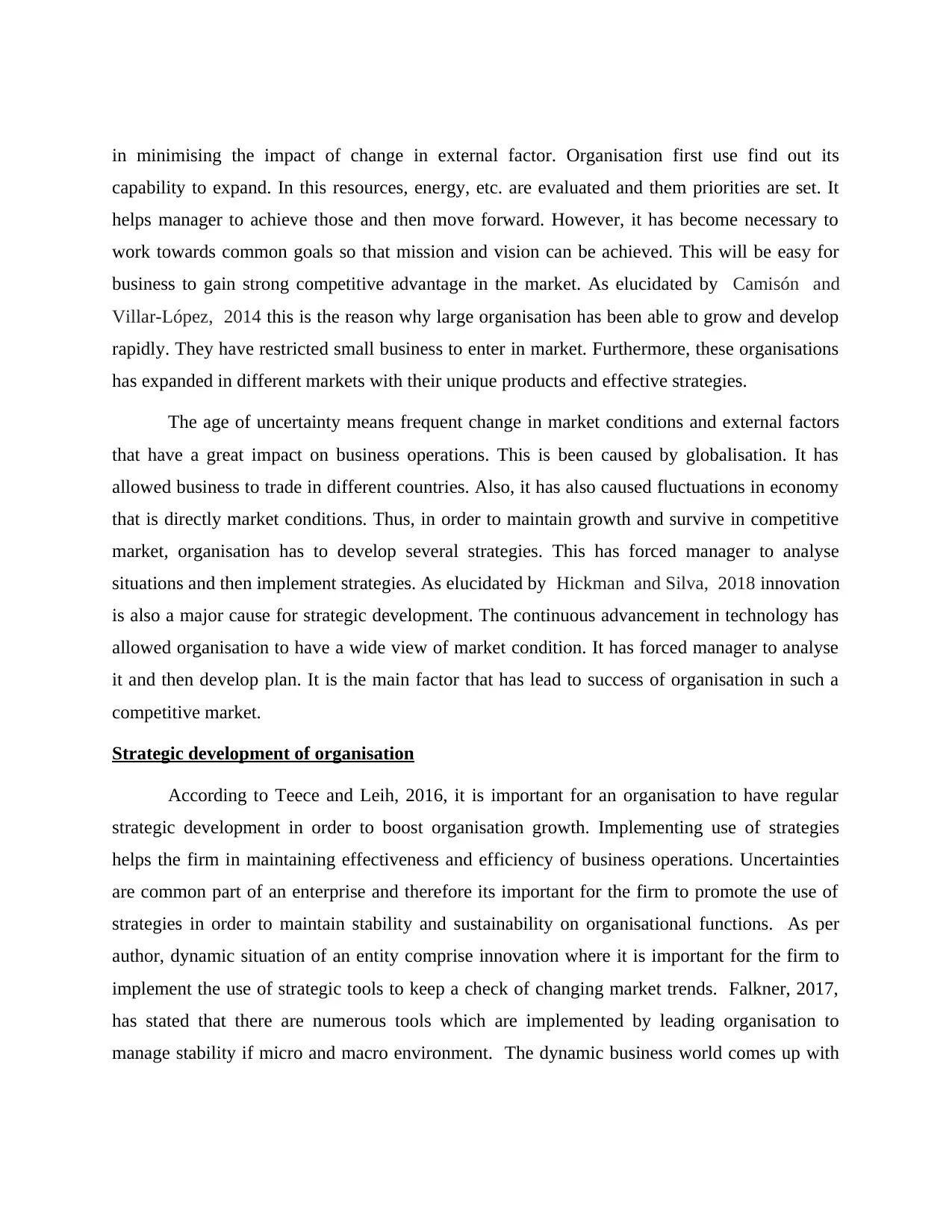
in minimising the impact of change in external factor. Organisation first use find out its
capability to expand. In this resources, energy, etc. are evaluated and them priorities are set. It
helps manager to achieve those and then move forward. However, it has become necessary to
work towards common goals so that mission and vision can be achieved. This will be easy for
business to gain strong competitive advantage in the market. As elucidated by Camisón and
Villar-López, 2014 this is the reason why large organisation has been able to grow and develop
rapidly. They have restricted small business to enter in market. Furthermore, these organisations
has expanded in different markets with their unique products and effective strategies.
The age of uncertainty means frequent change in market conditions and external factors
that have a great impact on business operations. This is been caused by globalisation. It has
allowed business to trade in different countries. Also, it has also caused fluctuations in economy
that is directly market conditions. Thus, in order to maintain growth and survive in competitive
market, organisation has to develop several strategies. This has forced manager to analyse
situations and then implement strategies. As elucidated by Hickman and Silva, 2018 innovation
is also a major cause for strategic development. The continuous advancement in technology has
allowed organisation to have a wide view of market condition. It has forced manager to analyse
it and then develop plan. It is the main factor that has lead to success of organisation in such a
competitive market.
Strategic development of organisation
According to Teece and Leih, 2016, it is important for an organisation to have regular
strategic development in order to boost organisation growth. Implementing use of strategies
helps the firm in maintaining effectiveness and efficiency of business operations. Uncertainties
are common part of an enterprise and therefore its important for the firm to promote the use of
strategies in order to maintain stability and sustainability on organisational functions. As per
author, dynamic situation of an entity comprise innovation where it is important for the firm to
implement the use of strategic tools to keep a check of changing market trends. Falkner, 2017,
has stated that there are numerous tools which are implemented by leading organisation to
manage stability if micro and macro environment. The dynamic business world comes up with
capability to expand. In this resources, energy, etc. are evaluated and them priorities are set. It
helps manager to achieve those and then move forward. However, it has become necessary to
work towards common goals so that mission and vision can be achieved. This will be easy for
business to gain strong competitive advantage in the market. As elucidated by Camisón and
Villar-López, 2014 this is the reason why large organisation has been able to grow and develop
rapidly. They have restricted small business to enter in market. Furthermore, these organisations
has expanded in different markets with their unique products and effective strategies.
The age of uncertainty means frequent change in market conditions and external factors
that have a great impact on business operations. This is been caused by globalisation. It has
allowed business to trade in different countries. Also, it has also caused fluctuations in economy
that is directly market conditions. Thus, in order to maintain growth and survive in competitive
market, organisation has to develop several strategies. This has forced manager to analyse
situations and then implement strategies. As elucidated by Hickman and Silva, 2018 innovation
is also a major cause for strategic development. The continuous advancement in technology has
allowed organisation to have a wide view of market condition. It has forced manager to analyse
it and then develop plan. It is the main factor that has lead to success of organisation in such a
competitive market.
Strategic development of organisation
According to Teece and Leih, 2016, it is important for an organisation to have regular
strategic development in order to boost organisation growth. Implementing use of strategies
helps the firm in maintaining effectiveness and efficiency of business operations. Uncertainties
are common part of an enterprise and therefore its important for the firm to promote the use of
strategies in order to maintain stability and sustainability on organisational functions. As per
author, dynamic situation of an entity comprise innovation where it is important for the firm to
implement the use of strategic tools to keep a check of changing market trends. Falkner, 2017,
has stated that there are numerous tools which are implemented by leading organisation to
manage stability if micro and macro environment. The dynamic business world comes up with
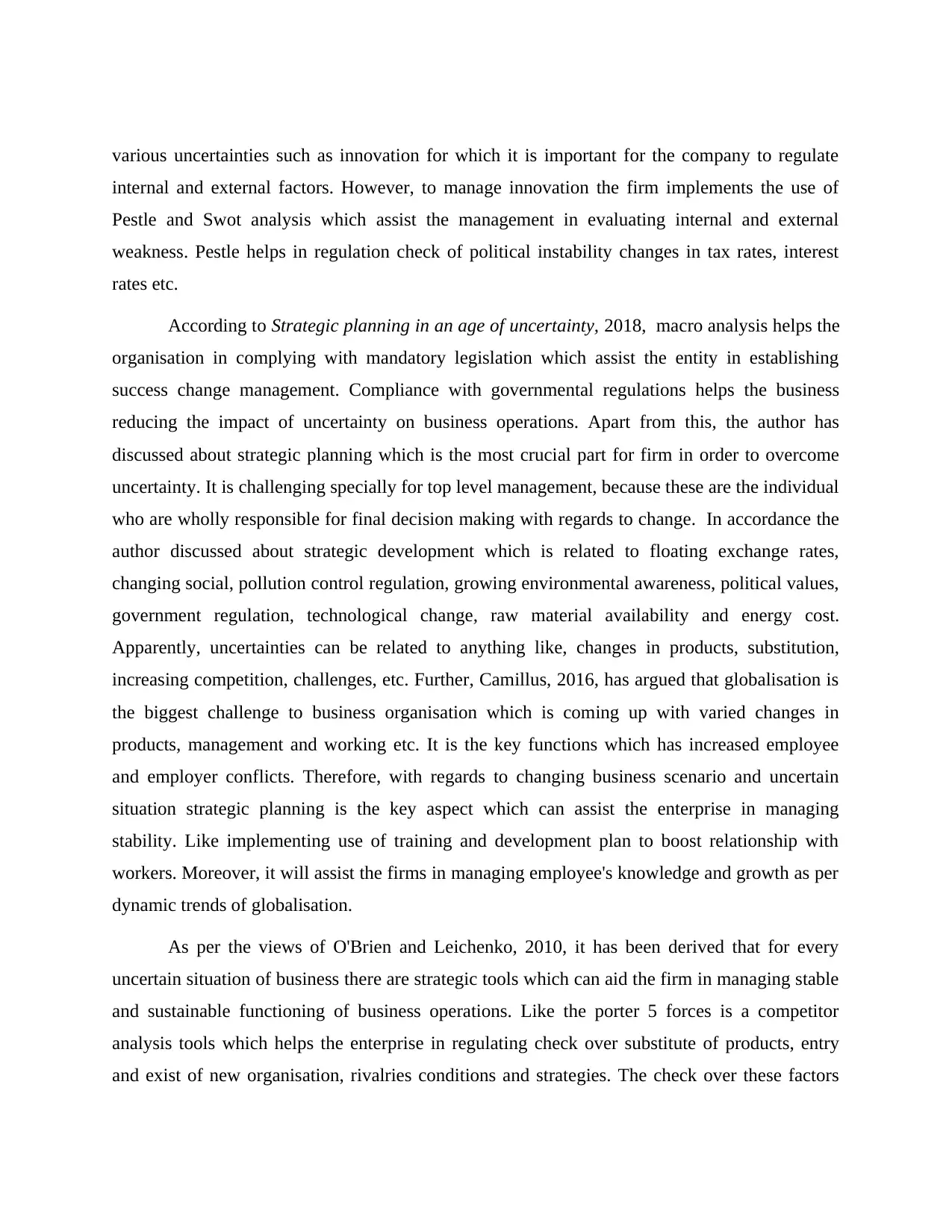
various uncertainties such as innovation for which it is important for the company to regulate
internal and external factors. However, to manage innovation the firm implements the use of
Pestle and Swot analysis which assist the management in evaluating internal and external
weakness. Pestle helps in regulation check of political instability changes in tax rates, interest
rates etc.
According to Strategic planning in an age of uncertainty, 2018, macro analysis helps the
organisation in complying with mandatory legislation which assist the entity in establishing
success change management. Compliance with governmental regulations helps the business
reducing the impact of uncertainty on business operations. Apart from this, the author has
discussed about strategic planning which is the most crucial part for firm in order to overcome
uncertainty. It is challenging specially for top level management, because these are the individual
who are wholly responsible for final decision making with regards to change. In accordance the
author discussed about strategic development which is related to floating exchange rates,
changing social, pollution control regulation, growing environmental awareness, political values,
government regulation, technological change, raw material availability and energy cost.
Apparently, uncertainties can be related to anything like, changes in products, substitution,
increasing competition, challenges, etc. Further, Camillus, 2016, has argued that globalisation is
the biggest challenge to business organisation which is coming up with varied changes in
products, management and working etc. It is the key functions which has increased employee
and employer conflicts. Therefore, with regards to changing business scenario and uncertain
situation strategic planning is the key aspect which can assist the enterprise in managing
stability. Like implementing use of training and development plan to boost relationship with
workers. Moreover, it will assist the firms in managing employee's knowledge and growth as per
dynamic trends of globalisation.
As per the views of O'Brien and Leichenko, 2010, it has been derived that for every
uncertain situation of business there are strategic tools which can aid the firm in managing stable
and sustainable functioning of business operations. Like the porter 5 forces is a competitor
analysis tools which helps the enterprise in regulating check over substitute of products, entry
and exist of new organisation, rivalries conditions and strategies. The check over these factors
internal and external factors. However, to manage innovation the firm implements the use of
Pestle and Swot analysis which assist the management in evaluating internal and external
weakness. Pestle helps in regulation check of political instability changes in tax rates, interest
rates etc.
According to Strategic planning in an age of uncertainty, 2018, macro analysis helps the
organisation in complying with mandatory legislation which assist the entity in establishing
success change management. Compliance with governmental regulations helps the business
reducing the impact of uncertainty on business operations. Apart from this, the author has
discussed about strategic planning which is the most crucial part for firm in order to overcome
uncertainty. It is challenging specially for top level management, because these are the individual
who are wholly responsible for final decision making with regards to change. In accordance the
author discussed about strategic development which is related to floating exchange rates,
changing social, pollution control regulation, growing environmental awareness, political values,
government regulation, technological change, raw material availability and energy cost.
Apparently, uncertainties can be related to anything like, changes in products, substitution,
increasing competition, challenges, etc. Further, Camillus, 2016, has argued that globalisation is
the biggest challenge to business organisation which is coming up with varied changes in
products, management and working etc. It is the key functions which has increased employee
and employer conflicts. Therefore, with regards to changing business scenario and uncertain
situation strategic planning is the key aspect which can assist the enterprise in managing
stability. Like implementing use of training and development plan to boost relationship with
workers. Moreover, it will assist the firms in managing employee's knowledge and growth as per
dynamic trends of globalisation.
As per the views of O'Brien and Leichenko, 2010, it has been derived that for every
uncertain situation of business there are strategic tools which can aid the firm in managing stable
and sustainable functioning of business operations. Like the porter 5 forces is a competitor
analysis tools which helps the enterprise in regulating check over substitute of products, entry
and exist of new organisation, rivalries conditions and strategies. The check over these factors
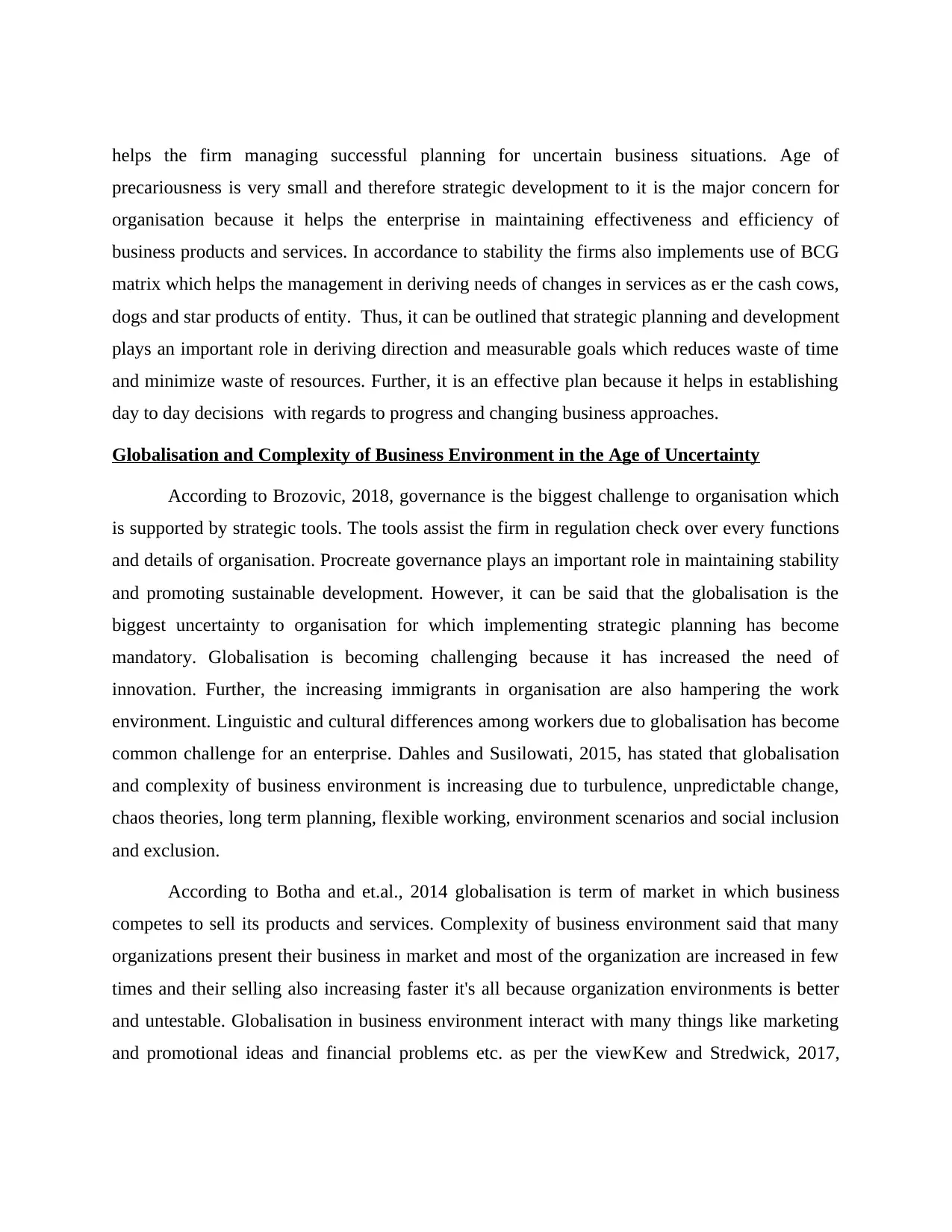
helps the firm managing successful planning for uncertain business situations. Age of
precariousness is very small and therefore strategic development to it is the major concern for
organisation because it helps the enterprise in maintaining effectiveness and efficiency of
business products and services. In accordance to stability the firms also implements use of BCG
matrix which helps the management in deriving needs of changes in services as er the cash cows,
dogs and star products of entity. Thus, it can be outlined that strategic planning and development
plays an important role in deriving direction and measurable goals which reduces waste of time
and minimize waste of resources. Further, it is an effective plan because it helps in establishing
day to day decisions with regards to progress and changing business approaches.
Globalisation and Complexity of Business Environment in the Age of Uncertainty
According to Brozovic, 2018, governance is the biggest challenge to organisation which
is supported by strategic tools. The tools assist the firm in regulation check over every functions
and details of organisation. Procreate governance plays an important role in maintaining stability
and promoting sustainable development. However, it can be said that the globalisation is the
biggest uncertainty to organisation for which implementing strategic planning has become
mandatory. Globalisation is becoming challenging because it has increased the need of
innovation. Further, the increasing immigrants in organisation are also hampering the work
environment. Linguistic and cultural differences among workers due to globalisation has become
common challenge for an enterprise. Dahles and Susilowati, 2015, has stated that globalisation
and complexity of business environment is increasing due to turbulence, unpredictable change,
chaos theories, long term planning, flexible working, environment scenarios and social inclusion
and exclusion.
According to Botha and et.al., 2014 globalisation is term of market in which business
competes to sell its products and services. Complexity of business environment said that many
organizations present their business in market and most of the organization are increased in few
times and their selling also increasing faster it's all because organization environments is better
and untestable. Globalisation in business environment interact with many things like marketing
and promotional ideas and financial problems etc. as per the viewKew and Stredwick, 2017,
precariousness is very small and therefore strategic development to it is the major concern for
organisation because it helps the enterprise in maintaining effectiveness and efficiency of
business products and services. In accordance to stability the firms also implements use of BCG
matrix which helps the management in deriving needs of changes in services as er the cash cows,
dogs and star products of entity. Thus, it can be outlined that strategic planning and development
plays an important role in deriving direction and measurable goals which reduces waste of time
and minimize waste of resources. Further, it is an effective plan because it helps in establishing
day to day decisions with regards to progress and changing business approaches.
Globalisation and Complexity of Business Environment in the Age of Uncertainty
According to Brozovic, 2018, governance is the biggest challenge to organisation which
is supported by strategic tools. The tools assist the firm in regulation check over every functions
and details of organisation. Procreate governance plays an important role in maintaining stability
and promoting sustainable development. However, it can be said that the globalisation is the
biggest uncertainty to organisation for which implementing strategic planning has become
mandatory. Globalisation is becoming challenging because it has increased the need of
innovation. Further, the increasing immigrants in organisation are also hampering the work
environment. Linguistic and cultural differences among workers due to globalisation has become
common challenge for an enterprise. Dahles and Susilowati, 2015, has stated that globalisation
and complexity of business environment is increasing due to turbulence, unpredictable change,
chaos theories, long term planning, flexible working, environment scenarios and social inclusion
and exclusion.
According to Botha and et.al., 2014 globalisation is term of market in which business
competes to sell its products and services. Complexity of business environment said that many
organizations present their business in market and most of the organization are increased in few
times and their selling also increasing faster it's all because organization environments is better
and untestable. Globalisation in business environment interact with many things like marketing
and promotional ideas and financial problems etc. as per the viewKew and Stredwick, 2017,
Paraphrase This Document
Need a fresh take? Get an instant paraphrase of this document with our AI Paraphraser
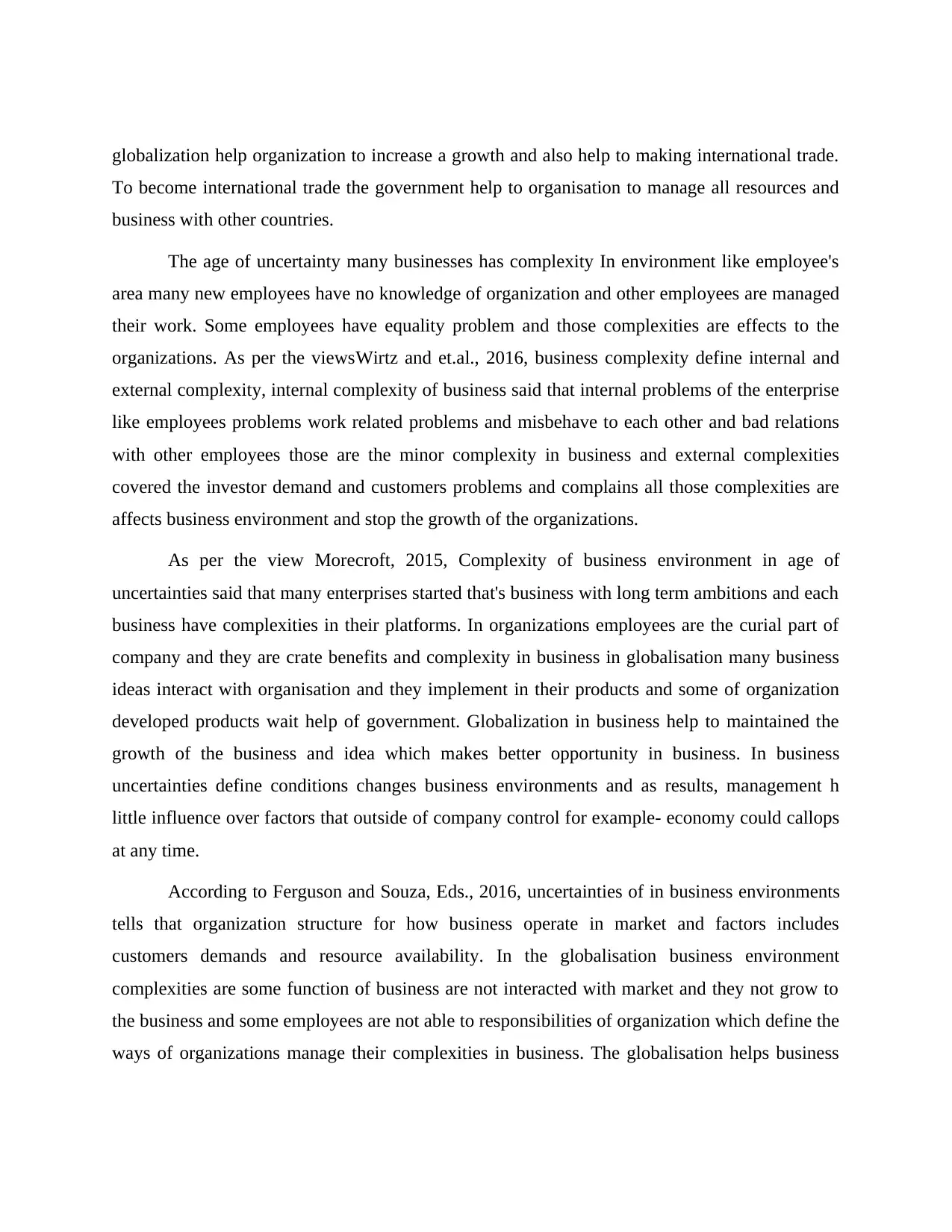
globalization help organization to increase a growth and also help to making international trade.
To become international trade the government help to organisation to manage all resources and
business with other countries.
The age of uncertainty many businesses has complexity In environment like employee's
area many new employees have no knowledge of organization and other employees are managed
their work. Some employees have equality problem and those complexities are effects to the
organizations. As per the viewsWirtz and et.al., 2016, business complexity define internal and
external complexity, internal complexity of business said that internal problems of the enterprise
like employees problems work related problems and misbehave to each other and bad relations
with other employees those are the minor complexity in business and external complexities
covered the investor demand and customers problems and complains all those complexities are
affects business environment and stop the growth of the organizations.
As per the view Morecroft, 2015, Complexity of business environment in age of
uncertainties said that many enterprises started that's business with long term ambitions and each
business have complexities in their platforms. In organizations employees are the curial part of
company and they are crate benefits and complexity in business in globalisation many business
ideas interact with organisation and they implement in their products and some of organization
developed products wait help of government. Globalization in business help to maintained the
growth of the business and idea which makes better opportunity in business. In business
uncertainties define conditions changes business environments and as results, management h
little influence over factors that outside of company control for example- economy could callops
at any time.
According to Ferguson and Souza, Eds., 2016, uncertainties of in business environments
tells that organization structure for how business operate in market and factors includes
customers demands and resource availability. In the globalisation business environment
complexities are some function of business are not interacted with market and they not grow to
the business and some employees are not able to responsibilities of organization which define the
ways of organizations manage their complexities in business. The globalisation helps business
To become international trade the government help to organisation to manage all resources and
business with other countries.
The age of uncertainty many businesses has complexity In environment like employee's
area many new employees have no knowledge of organization and other employees are managed
their work. Some employees have equality problem and those complexities are effects to the
organizations. As per the viewsWirtz and et.al., 2016, business complexity define internal and
external complexity, internal complexity of business said that internal problems of the enterprise
like employees problems work related problems and misbehave to each other and bad relations
with other employees those are the minor complexity in business and external complexities
covered the investor demand and customers problems and complains all those complexities are
affects business environment and stop the growth of the organizations.
As per the view Morecroft, 2015, Complexity of business environment in age of
uncertainties said that many enterprises started that's business with long term ambitions and each
business have complexities in their platforms. In organizations employees are the curial part of
company and they are crate benefits and complexity in business in globalisation many business
ideas interact with organisation and they implement in their products and some of organization
developed products wait help of government. Globalization in business help to maintained the
growth of the business and idea which makes better opportunity in business. In business
uncertainties define conditions changes business environments and as results, management h
little influence over factors that outside of company control for example- economy could callops
at any time.
According to Ferguson and Souza, Eds., 2016, uncertainties of in business environments
tells that organization structure for how business operate in market and factors includes
customers demands and resource availability. In the globalisation business environment
complexities are some function of business are not interacted with market and they not grow to
the business and some employees are not able to responsibilities of organization which define the
ways of organizations manage their complexities in business. The globalisation helps business
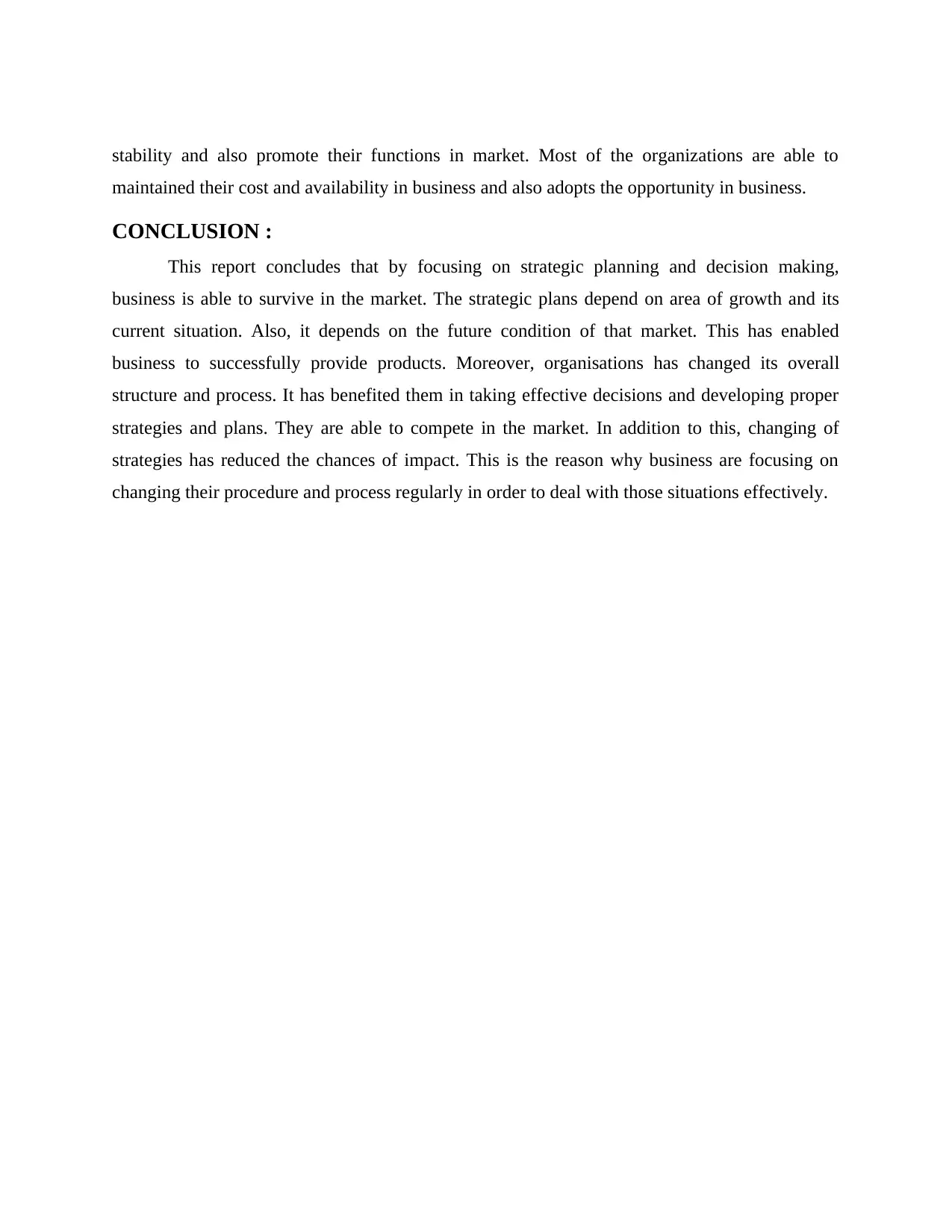
stability and also promote their functions in market. Most of the organizations are able to
maintained their cost and availability in business and also adopts the opportunity in business.
CONCLUSION :
This report concludes that by focusing on strategic planning and decision making,
business is able to survive in the market. The strategic plans depend on area of growth and its
current situation. Also, it depends on the future condition of that market. This has enabled
business to successfully provide products. Moreover, organisations has changed its overall
structure and process. It has benefited them in taking effective decisions and developing proper
strategies and plans. They are able to compete in the market. In addition to this, changing of
strategies has reduced the chances of impact. This is the reason why business are focusing on
changing their procedure and process regularly in order to deal with those situations effectively.
maintained their cost and availability in business and also adopts the opportunity in business.
CONCLUSION :
This report concludes that by focusing on strategic planning and decision making,
business is able to survive in the market. The strategic plans depend on area of growth and its
current situation. Also, it depends on the future condition of that market. This has enabled
business to successfully provide products. Moreover, organisations has changed its overall
structure and process. It has benefited them in taking effective decisions and developing proper
strategies and plans. They are able to compete in the market. In addition to this, changing of
strategies has reduced the chances of impact. This is the reason why business are focusing on
changing their procedure and process regularly in order to deal with those situations effectively.
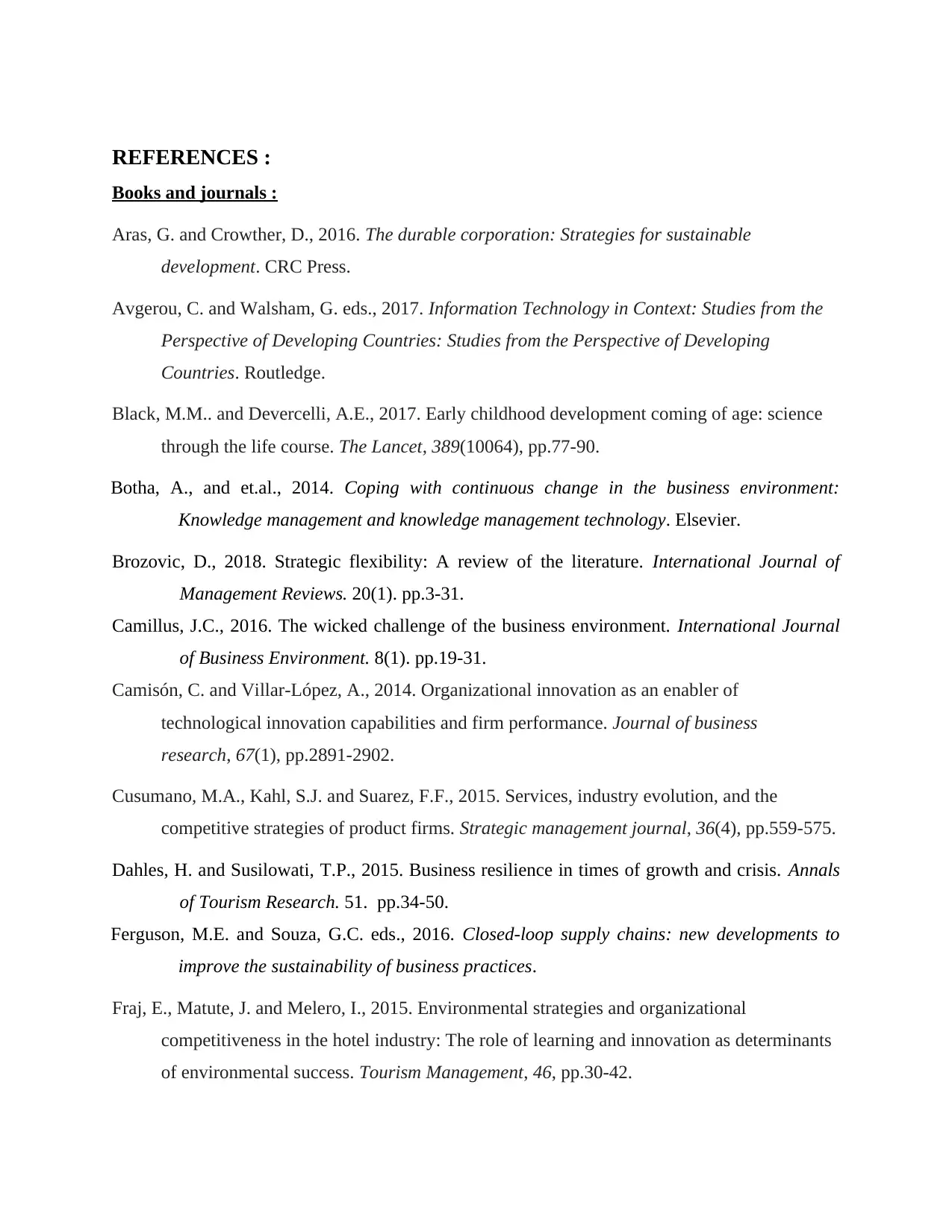
REFERENCES :
Books and journals :
Aras, G. and Crowther, D., 2016. The durable corporation: Strategies for sustainable
development. CRC Press.
Avgerou, C. and Walsham, G. eds., 2017. Information Technology in Context: Studies from the
Perspective of Developing Countries: Studies from the Perspective of Developing
Countries. Routledge.
Black, M.M.. and Devercelli, A.E., 2017. Early childhood development coming of age: science
through the life course. The Lancet, 389(10064), pp.77-90.
Botha, A., and et.al., 2014. Coping with continuous change in the business environment:
Knowledge management and knowledge management technology. Elsevier.
Brozovic, D., 2018. Strategic flexibility: A review of the literature. International Journal of
Management Reviews. 20(1). pp.3-31.
Camillus, J.C., 2016. The wicked challenge of the business environment. International Journal
of Business Environment. 8(1). pp.19-31.
Camisón, C. and Villar-López, A., 2014. Organizational innovation as an enabler of
technological innovation capabilities and firm performance. Journal of business
research, 67(1), pp.2891-2902.
Cusumano, M.A., Kahl, S.J. and Suarez, F.F., 2015. Services, industry evolution, and the
competitive strategies of product firms. Strategic management journal, 36(4), pp.559-575.
Dahles, H. and Susilowati, T.P., 2015. Business resilience in times of growth and crisis. Annals
of Tourism Research. 51. pp.34-50.
Ferguson, M.E. and Souza, G.C. eds., 2016. Closed-loop supply chains: new developments to
improve the sustainability of business practices.
Fraj, E., Matute, J. and Melero, I., 2015. Environmental strategies and organizational
competitiveness in the hotel industry: The role of learning and innovation as determinants
of environmental success. Tourism Management, 46, pp.30-42.
Books and journals :
Aras, G. and Crowther, D., 2016. The durable corporation: Strategies for sustainable
development. CRC Press.
Avgerou, C. and Walsham, G. eds., 2017. Information Technology in Context: Studies from the
Perspective of Developing Countries: Studies from the Perspective of Developing
Countries. Routledge.
Black, M.M.. and Devercelli, A.E., 2017. Early childhood development coming of age: science
through the life course. The Lancet, 389(10064), pp.77-90.
Botha, A., and et.al., 2014. Coping with continuous change in the business environment:
Knowledge management and knowledge management technology. Elsevier.
Brozovic, D., 2018. Strategic flexibility: A review of the literature. International Journal of
Management Reviews. 20(1). pp.3-31.
Camillus, J.C., 2016. The wicked challenge of the business environment. International Journal
of Business Environment. 8(1). pp.19-31.
Camisón, C. and Villar-López, A., 2014. Organizational innovation as an enabler of
technological innovation capabilities and firm performance. Journal of business
research, 67(1), pp.2891-2902.
Cusumano, M.A., Kahl, S.J. and Suarez, F.F., 2015. Services, industry evolution, and the
competitive strategies of product firms. Strategic management journal, 36(4), pp.559-575.
Dahles, H. and Susilowati, T.P., 2015. Business resilience in times of growth and crisis. Annals
of Tourism Research. 51. pp.34-50.
Ferguson, M.E. and Souza, G.C. eds., 2016. Closed-loop supply chains: new developments to
improve the sustainability of business practices.
Fraj, E., Matute, J. and Melero, I., 2015. Environmental strategies and organizational
competitiveness in the hotel industry: The role of learning and innovation as determinants
of environmental success. Tourism Management, 46, pp.30-42.
Secure Best Marks with AI Grader
Need help grading? Try our AI Grader for instant feedback on your assignments.
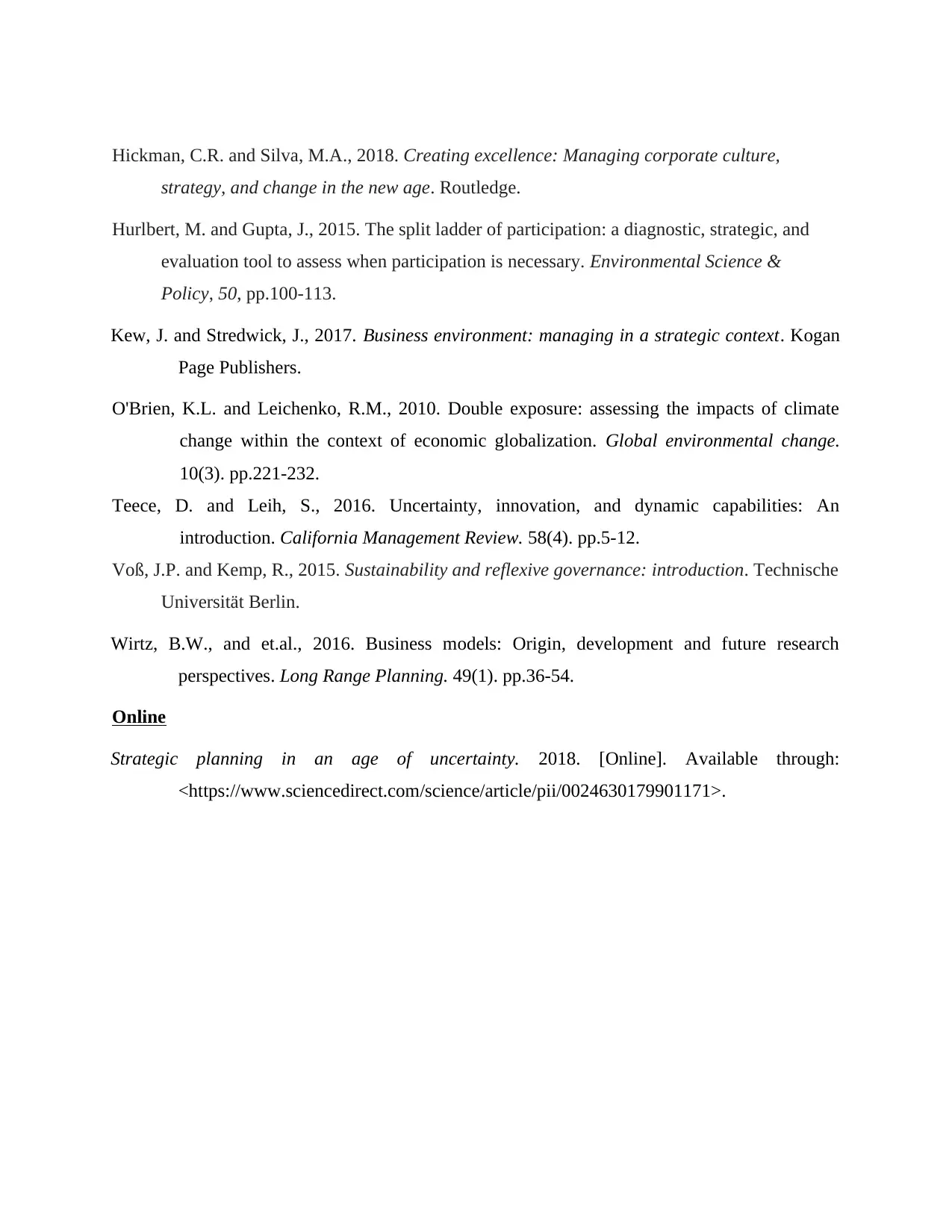
Hickman, C.R. and Silva, M.A., 2018. Creating excellence: Managing corporate culture,
strategy, and change in the new age. Routledge.
Hurlbert, M. and Gupta, J., 2015. The split ladder of participation: a diagnostic, strategic, and
evaluation tool to assess when participation is necessary. Environmental Science &
Policy, 50, pp.100-113.
Kew, J. and Stredwick, J., 2017. Business environment: managing in a strategic context. Kogan
Page Publishers.
O'Brien, K.L. and Leichenko, R.M., 2010. Double exposure: assessing the impacts of climate
change within the context of economic globalization. Global environmental change.
10(3). pp.221-232.
Teece, D. and Leih, S., 2016. Uncertainty, innovation, and dynamic capabilities: An
introduction. California Management Review. 58(4). pp.5-12.
Voß, J.P. and Kemp, R., 2015. Sustainability and reflexive governance: introduction. Technische
Universität Berlin.
Wirtz, B.W., and et.al., 2016. Business models: Origin, development and future research
perspectives. Long Range Planning. 49(1). pp.36-54.
Online
Strategic planning in an age of uncertainty. 2018. [Online]. Available through:
<https://www.sciencedirect.com/science/article/pii/0024630179901171>.
strategy, and change in the new age. Routledge.
Hurlbert, M. and Gupta, J., 2015. The split ladder of participation: a diagnostic, strategic, and
evaluation tool to assess when participation is necessary. Environmental Science &
Policy, 50, pp.100-113.
Kew, J. and Stredwick, J., 2017. Business environment: managing in a strategic context. Kogan
Page Publishers.
O'Brien, K.L. and Leichenko, R.M., 2010. Double exposure: assessing the impacts of climate
change within the context of economic globalization. Global environmental change.
10(3). pp.221-232.
Teece, D. and Leih, S., 2016. Uncertainty, innovation, and dynamic capabilities: An
introduction. California Management Review. 58(4). pp.5-12.
Voß, J.P. and Kemp, R., 2015. Sustainability and reflexive governance: introduction. Technische
Universität Berlin.
Wirtz, B.W., and et.al., 2016. Business models: Origin, development and future research
perspectives. Long Range Planning. 49(1). pp.36-54.
Online
Strategic planning in an age of uncertainty. 2018. [Online]. Available through:
<https://www.sciencedirect.com/science/article/pii/0024630179901171>.

1 out of 12
Related Documents
Your All-in-One AI-Powered Toolkit for Academic Success.
+13062052269
info@desklib.com
Available 24*7 on WhatsApp / Email
![[object Object]](/_next/static/media/star-bottom.7253800d.svg)
Unlock your academic potential
© 2024 | Zucol Services PVT LTD | All rights reserved.





